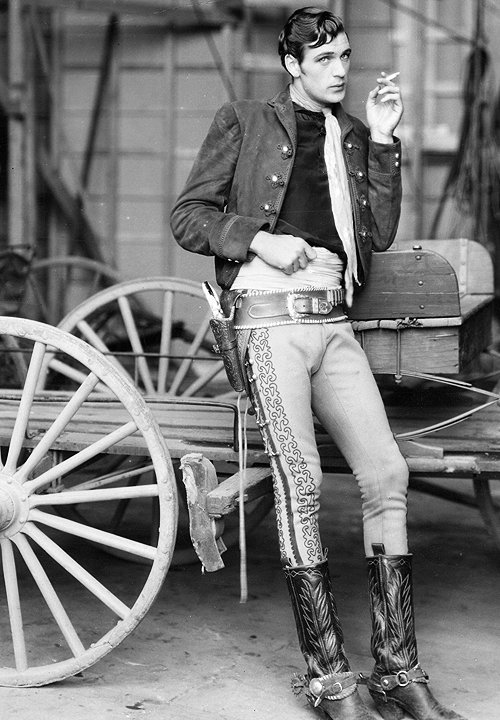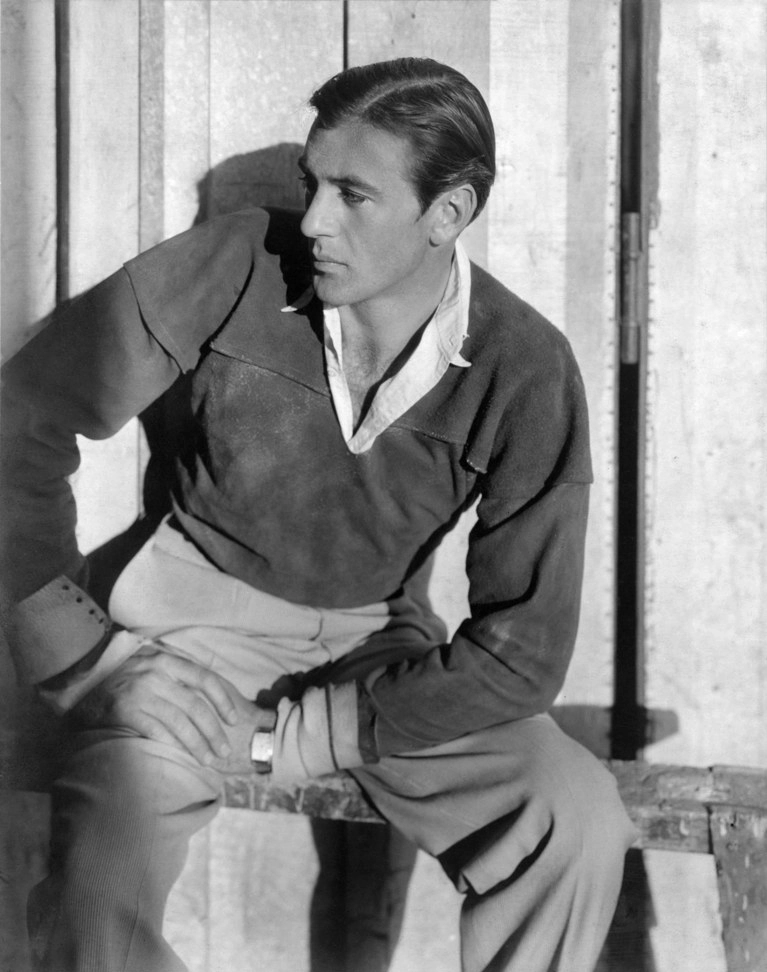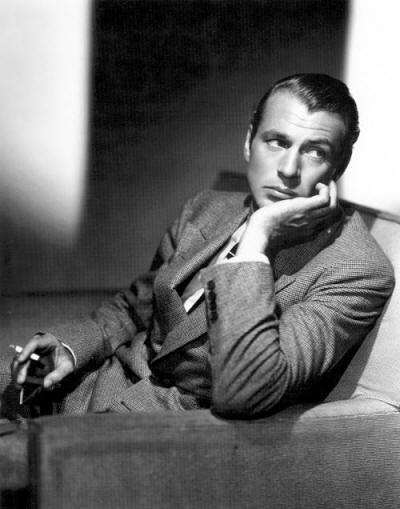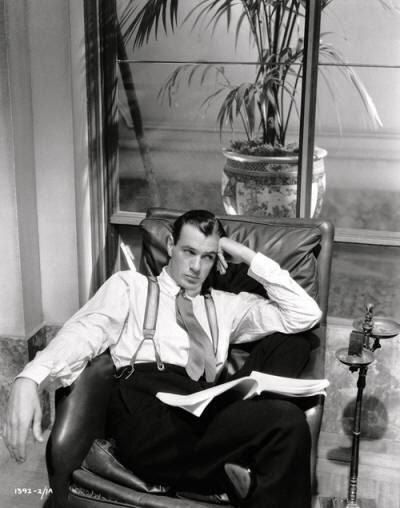

Queer Places:
730 11th Ave, Helena, MT 59601
712 5th Ave, Helena, MT 59601
7511 Franklin Ave, Los Angeles, CA 90046
1826 Laurel Canyon Blvd, Los Angeles, CA 90046
1919 Argyle Ave, Los Angeles, CA 90068
200 Baroda Dr, Los Angeles, CA 90077
Sacred Hearts of Jesus & Mary R.C. Cemetery
Southampton, Suffolk County, New York, USA
 Gary Cooper (born Frank James Cooper; May 7, 1901 – May 13, 1961) was an American actor known for his natural, authentic, and understated acting style. He won the Academy Award for Best Actor twice and had a further three nominations, as well as receiving an Academy Honorary Award for his career achievements in 1961. He was one of the top 10 film personalities for 23 consecutive years, and one of the top money-making stars for 18 years. The American Film Institute (AFI) ranked Cooper at No. 11 on its list of the 25 greatest male stars of classic Hollywood cinema.
Gary Cooper (born Frank James Cooper; May 7, 1901 – May 13, 1961) was an American actor known for his natural, authentic, and understated acting style. He won the Academy Award for Best Actor twice and had a further three nominations, as well as receiving an Academy Honorary Award for his career achievements in 1961. He was one of the top 10 film personalities for 23 consecutive years, and one of the top money-making stars for 18 years. The American Film Institute (AFI) ranked Cooper at No. 11 on its list of the 25 greatest male stars of classic Hollywood cinema.
For three years during the late 1920s über-rich Howard Hughes maintained a sexual relationship with a young, unknown but upcoming actor named Gary Cooper, buying him cars, watches, clothes and other lavish gifts along the way. At the time, Cooper, while playing only bit parts in silent films, was being supported financially by handsome silent film actor Rod La Rocque, who refused to buy him a car. La Rocque was also rumored to have had a relationship with Clark Gable on the set of Ernst Lubitsch’s Forbidden Paradise (1924).
Freshly arrived from Helena, Montana, Cooper was tall (6’3”), devastatingly handsome and possessed of a legendary endowment, using his physical assets to acquire material goods from older, much wealthier men and women. Hughes was also bisexual, also well-endowed, and possessed of an obsession for bedding the most beautiful and glamorous people, regardless of their sex. For Cooper, his arrangement with Hughes was unusual in that Hughes was actually a few years younger than he.
At the tender age of 26, Cooper’s two-minute appearance as Cadet White in the silent film masterpiece Wings (1927) became his breakthrough role, leading to his career-making star turn in the talking film The Virginian (1929).

Photographed in 1932 by Cecil Beaton


Hughes’s attention span was notoriously short, however, and his infatuation with Cooper cooled as he next set his sights on the dashing William Boyd, later known to millions as Hopalong Cassidy. Boyd’s costar Louis Wolheim once mentioned that the dazzlingly handsome Boyd, although basically heterosexual, wasn’t averse to letting a man service him if he felt it would advance his career. Both Boyd and Cooper would attend the all-nude male beach parties on Catalina Island hosted by bisexual actor Richard Arlen.
In 1928 Anderson Lawler started a relationship with Gary Cooper. In letters to his mother in Virginia, Lawler wrote of slipping away with Cooper to Catalina Island for the weekend, a break from the studio and Gary's volatile girlfriend, Lupe Velez. It would just be the two of them. Just the guys. Yet Lawler sounded like a schoolgirl. Cooper was "a fine boy," he wrote, assuming his mother she'd like him. He described their idyll on the island, scaling a mountain, sitting shoulder to shoulder and looking down at "the sea as blue as the sky."
Lawler was in love with Gary Cooper. In one scrapbook Lawler pasted pictures of Cooper carefully cut from fan magazines. Beside them is mounted every clipping mentioning the two of them together, along with every photograph and every telegram Gary ever sent him, all carefully pasted and preserved.
A few months before their Cataline excursion, Lawler had moved in with Cooper at 7511 Franklin Avenue, just a few blocks down from Zoe Akins and Jobyna Howland. Andy and Zoe were tight: she would always be on the lookout for parts for him in her plays and films.
Michael Pearman, close with Cole Porter and George Cukor, recalled coming to Hollywood in 1929 for a party at William Haines' showplace home on North Stanley Drive and seeing Anderson Lawler and Gary Cooper there together. Other friends corroborate, recalling the stories Haines would tell of the It Boy mixing with his crowd. Certainly Cooper wasn't blind to the impression he was creating by consorting with Lawler. "Andy Lawler was probably the best-known homosexual in Hollywood during that time," said Robert Wheaton, who knew Lawler through Cukor.
Lawler and Cooper met in mid-1929, soon after Lawler's arrival on the Paramount lot. Lawler was witty, erudite, and free with the bottle. With sandy hair that was thinning prematurely, he was cute rather than handsome, a freckle-faced puck with blue eyes. Cooper was then filming Betrayal with Emil Jannings. Lawler, strolling by, evinced fascination with Cooper's charcoal drawings of Jannings and Esther Ralston, and asked the star if he could see his other work. That night Cooper took Lawler home to show him his etchings. They became inseparable. For The Virginian, Cooper needed to adopt a Southern accent, so he asked the Alabama-born Anderson Lawler to coach him. When Gary decided it was time to move out of his parents' home, Lupe Velez suggested they move in together. But instead he decided to get his own place, and Lawler moved in with him.
After Cooper became an American icon, the facts of his relationship with Anderson Lawler were denied, ignored, and then forgotten. What stories survived mutated into tales of an older, wealthy homosexual who "kept" Cooper in the early days. In these accounts, Cooper was not the homosexual himself, but rather an ambitious boy consenting to reap the benefits of his patron's influence, as so many straight actors have done troughout Hollywood history.
But Anderson Lawler was neither wealthy nor influential; if anything, it was Cooper (the far biggest star) who gave the boost to Lawler's career, not the other way around. When Lawler took a part in the ironically named play "Let Us Be Gay," (William Haines wired him for the L.A. premiere, "Now that Duse is dead, you are supreme"), the press items hyped the show by touting Lawler's "leisure time hunting with Gary Cooper... They have a joint collection of stuffed birds of prey."
The two friends had pet nicknames for each other: Lawler called Cooper "Jamey", and Cooper called Lawler "Nin". On nights Cooper wasn't out with Lupe Velez, he and Lawler attended the theater and concerts at the Hollywood Bowl. "Touched that you use your first moment of leisure to write me, thought I was forgotten," Cooper wired to Lawler on August 2, 1929. Cooper was in Hollywood, Lawler on the East Coast for a play. "It will be nice to see you again. So far I never approved of long-term contracts. Don't worry. G." On September 4, an attempt at reassurance of some kind: "Thanks for the nice letter," Cooper wrote to Lawler at the Biltmore Hotel in Providence. "Sorry you think I turned out bad. Will write. Love, G." A month later, it's Cooper who's on the road, writing Lawler on October 23, 1929, at the home they shared: "Flying to Tampa, arrive tomorrow. Let me know dope if any. Be home next week, old sock. Gary."
Their family did know about the relationship, said Lawler's relatives, and at least some believed it to be sexual. "Andy's brother Ernest knew," a nephew said. "Well, he knew what Andy told him. In his last years, he revealed a lot to me. I think he felt that he had an obligation to pass on certain bits of "historical" data and I seemed to be the only one interested at the time."
A blind item, clearly placed by press agents, follows up interestingly on itself, saying Gary Cooper and Lupe Velez "are more "that way" than ever," perhaps to reassure fans skeptical of the "chumming" with Lawler. The item then immediately segues to Lawler and Nils Asther sunbathing "stag" on the Hollywood Athletic Club roof. Perhaps, an in-joke from a scribe who knew more than he let on.
By the middle of 1930 Lawler was freelancing: his dreams of fortune and fame were not to be. He and Cooper would remain friendly, but Lawler moved out of "Jamey's" and into George Cukor's. Soon after, Cooper quarreled with Velez and with his parents, then suffered a breakdown. His weight dropped from 180 to 148 pounds. Blaming it on overwork, the studio sent him to Europe to recover. There Cooper met the considerably older Countess Dorothy di Frasso, one of Hollywood's most delicious hostesses. He'd return to screenland several months later on the countess' arm, her very public gigolo.
According to Hollywood chronicler William J. Mann, Gary Cooper suffered a devastating breakdown after the studio-engineered split from Lawler. Nevertheless, after an initial distancing, Cooper and Lawler reunited as lifelong friends. Their special relationship is referenced in both Jeffrey Meyer's biography Gary Cooper: American Hero and Larry Sidwell's The Last Hero: A Biography of Gary Cooper.
Cooper was formally introduced to his future wife, 20-year-old New York debutante Veronica Balfe,[Note 6] on Easter Sunday 1933 at a party given by her uncle, art director Cedric Gibbons.[292][293][294] Called "Rocky" by her family and friends, she grew up on Park Avenue and attended finishing schools.[295] Her stepfather was Wall Street tycoon Paul Shields.[295] Cooper and Rocky were quietly married at her parents' Park Avenue residence on December 15, 1933.[296] According to his friends, the marriage had a positive impact on Cooper, who turned away from past indiscretions and took control of his life.[297] Athletic and a lover of the outdoors, Rocky shared many of Cooper's interests, including riding, skiing, and skeet-shooting.[298] She organized their social life, and her wealth and social connections provided Cooper access to New York high society.[299] Cooper and his wife owned homes in the Los Angeles area in Encino (1933–36),[297] Brentwood (1936–53),[297] and Holmby Hills (1954–61),[300] and owned a vacation home in Aspen, Colorado (1949–53).[301][Note 7]
Gary and Veronica Cooper's daughter, Maria Veronica Cooper, was born on September 15, 1937.[302] By all accounts, he was a patient and affectionate father, teaching Maria to ride a bicycle, play tennis, ski, and ride horses.[302] Sharing many of her parents' interests, she accompanied them on their travels and was often photographed with them.[302] Like her father, she developed a love for art and drawing.[303][Note 8] As a family they vacationed together in Sun Valley, Idaho, spent time at Rocky's parents' country house in Southampton, New York, and took frequent trips to Europe.[299] Cooper and Rocky were legally separated on May 16, 1951, when Cooper moved out of their home.[304] For over two years, they maintained a fragile and uneasy family life with their daughter.[305] Cooper moved back into their home in November 1953,[306][307] and their formal reconciliation occurred in February 1954.[263]
In later life, Cooper became involved in a relationship with the costume designer, Irene, and was, according to Irene, "the only man she ever loved". A year after his death in 1961, Irene committed suicide by jumping from the 11th floor of the Knickerbocker Hotel, after telling Doris Day of her grief over Cooper's death.[334]
My published books: